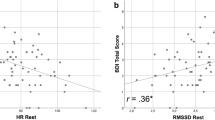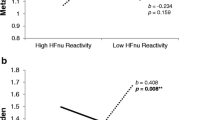Abstract
Resting heart rate variability can be an index of sympathetic or parasympathetic dominance, according to the frequency of the variability studied. Sympathetic dominance of this system has been linked to increased risk of cardiovascular disease (CVD). Similarly, rapid and dramatic increases in heart rate reactivity to a stressor task have also been suggested as indicating increased risk of CVD via atherogenesis. Although both of these variables have been related to the development of cardiovascular disease, and both may be related to increased sympathetic activity or parasympathetic withdrawal, most research studies have tended to focus on either variable independently of the other. In order to investigate whether these two indices of stressor reactivity were related in relatively young and healthy subjects, resting heart rate variability data were collected from 80 volunteers for 20 minutes. In addition, heart rate reactivity data were collected during a 2-minute mental arithmetic stressor, which has been previously shown to induce significant increases in heart rate. After classifying subjects according to whether their heart rate variability data were above or below the mean for their gender, heart rate reactivity data were examined via MANOVA to detect significant differences between subject groups. Females showed significant effects, and males showed nonsignificant trends, but these two sets of data were in different directions, suggesting that gender may be a confounding factor in the relationship between heart rate reactivity and heart rate variability.
Similar content being viewed by others
REFERENCES
Berntson, G., Bigger, J., Eckberg, D., Grossman, P., Kaufman, P., Malik, M., Nagaraja, H., Porges, S., Saul, J., Stone, P., & Van Der Molen, M. (1997). Heart rate variability: Origins, methods, and interpretive caveats. Psychophysiology, 34, 623–648.
Cincirippini, P. (1986). Cognitive stress and cardiovascular reactivity-I: Relationships to hypertension. American Heart Journal, 112, 1044–1050.
Cowan, M., Kogan, H., Burr, R., Hendershot, S., & Buchanan, L. (1990). Power spectral analysis of heart rate variability after biofeedback training. Journal of Electrocardiology, 23(Suppl.), 85–94.
del Paso, G., Godoy, J., & Vila, J. (1992). Self-regulation of respiratory sinus arrhythmia. Biofeedback and Self-Regulation, 17, 261–275.
Halon, D., Sapoznikov, D., Lewis, B., & Gotsman, M. (1983). Localization of lesions in coronary circulation. American Journal of Cardiology, 52, 921–926.
Huberty, C. J., & Morris, J. D. (1989). Multivariate analysis versus multiple univariate analyses. Psychological Bulletin, 105, 302–308.
Kamen, P., & Tonkin, A. (1995). Application of the Poincare plot to heart rate variability: A new measure of functional status in heart failure. Australian and New Zealand Journal of Medicine, 25, 18–26.
Kleiger, R., Miller, J., Bigger, J., & Moss, A. (1984). Heart rate variability: A variable predicting mortality following acute myocardial infarction. Journal of the American College of Cardiology, 3, 86–89.
Kleiger, R., Miller, J., Bigger, J., Moss, A., & Multicenter Post-Infarction Research Group. (1987). Decreased heart rate variability and its association with increased mortality after acute myocardial infarction. The American Journal of Cardiology, 59, 256–262.
Krantz, D., Contrada, R., Hill, D., & Freidler, E. (1988). Environmental stress and biobehavioral antecedents of coronary heart disease. Journal of Consulting & Clinical Psychology, 56, 333–341.
Krantz, D., & Manuck, S. (1984). Acute psychophysiologic reactivity and risk of cardiovascular disease: A review and methodologic critique. Psychological Bulletin, 96, 435–464.
Lane, J., Adcock, R., & Burnett, R. (1992). Respiratory sinus arrhythmia and cardiovascular responses to stress. Psychophysiology, 29, 461–470.
Langewitz, W., & Rudell, H. (1989). Spectral analysis of heart rate variability under mental stress. Journal of Hypertension, 7(suppl.), 32–33.
Manuck, S., & Garland, F. (1980). Stability of individual differences in cardiovascular reactivity: A thirteen-month follow up. Physiology and Behavior, 21, 621–624.
Martin, G., Magdid, N., Myers, G., Barbett, P., Schaad, J., Weiss, J., Lesch, M., & Singer, D. (1987). Heart rate variability and sudden death secondary to coronary artery disease during ambulatory electrocardiographic monitoring. The American Journal of Cardiology, 60, 86–89.
Matthews, K., Weiss, S., Detre, T., Dembroski, T., Falkner, B., Manuck, S., & Williams, R. (1986). Handbook of stress, reactivity, and cardiovascular disease. New York: John Wiley.
Murphy, J., Alpert, B., Willey, E., & Somes, G. (1988). Cardiovascular reactivity to psychological stress in healthy children. Psychophysiology, 25, 144–151.
Porges, S. W. (1994). Orienting in a defensive world: Mammalian modifications of our evolutionary heritage, a polyvagal theory. Psychophysiology, 32, 301–318.
Ross, R. (1986). The pathogenesis of atherosclerosis-an update. The New England Journal of Medicine, 314, 488–500.
Ross, R., & Glomset, J. (1976). The pathogenesis of atherosclerosis. The New England Journal of Medicine, 295, 420–425.
Sharpley, C. F. (1989). Biofeedback training versus simple instructions to reduce heart rate reactivity to a psychological stressor. Journal of Behavioral Medicine, 12, 435–448.
Sharpley, C. F. (1994). Maintenance and generalisability of laboratory-based heart rate reactivity control training. Journal of Behavioral Medicine, 17, 309–329.
Sharpley, C. F., & Gordon, J. (1999). Differences between ECG and pulse when measuring heart rate and reactivity under two physical and two psychological stressors. Journal of Behavioral Medicine, 22, 285–301.
Sharpley, C. F., & McLean, S. (1991). Incidence of laboratory-based heart rate reactivity during typical daily events. Journal of Behavioral Medicine, 14, 607–626.
Sharpley, C., & Scuderi, C. (1994). Gender and age correlates of adults' heart rate reactivity to a brief psychological stressor: Implications for Australian research and practice. Australian Psychologist, 29, 41–44.
Texon, M. (1980). Hemodynamic basis of atherosclerosis. New York: McGraw-Hill.
Author information
Authors and Affiliations
Rights and permissions
About this article
Cite this article
Sharpley, C.F., Kamen, P., Galatsis, M. et al. An Examination of the Relationship Between Resting Heart Rate Variability and Heart Rate Reactivity to a Mental Arithmetic Stressor. Appl Psychophysiol Biofeedback 25, 143–153 (2000). https://doi.org/10.1023/A:1009598607998
Issue Date:
DOI: https://doi.org/10.1023/A:1009598607998




